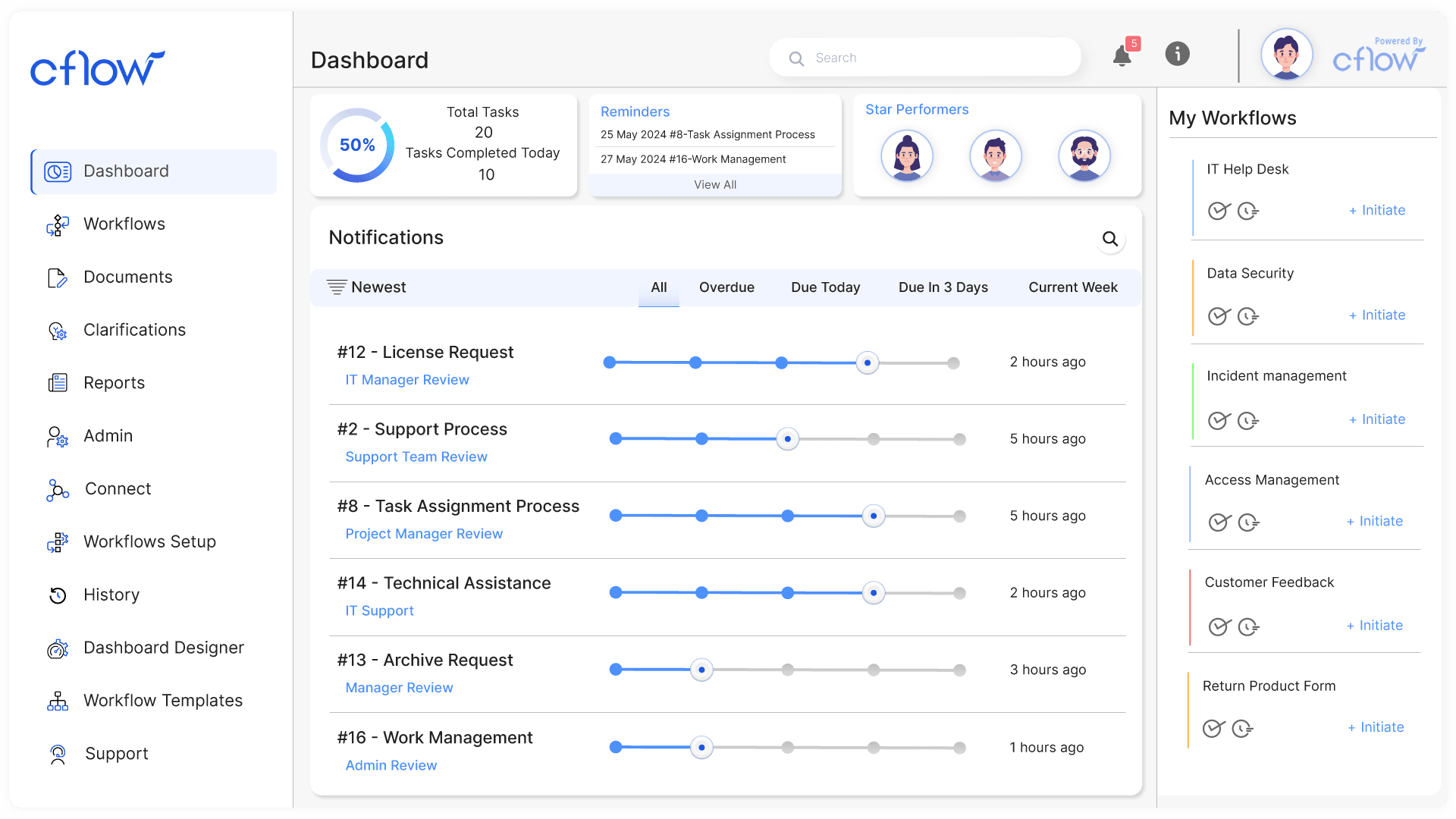BPM Tools to Manage Your Business Online
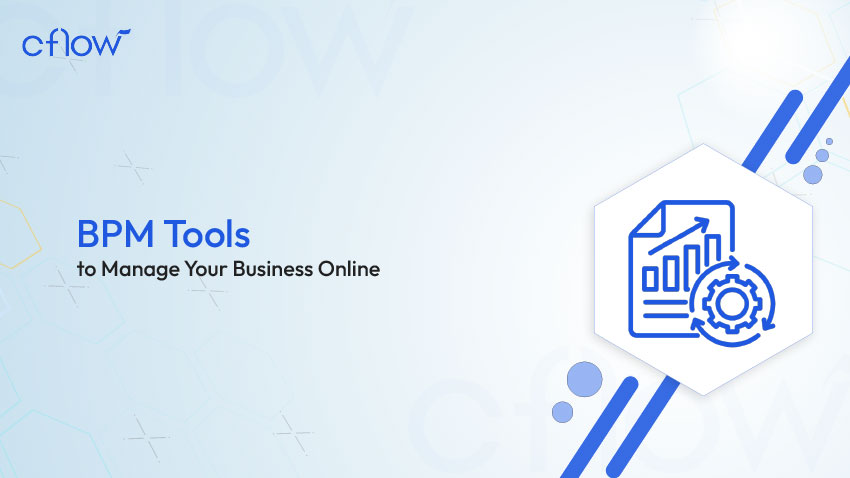
Key takeaways
- Business process management (BPM) tools help businesses set up, analyze, measure, improve, and optimize business strategies to boost productivity.
- BPM can be human-centric, document centric, and inteheration centric.
- The must-have features for BPM tools – interactive user interface, usability, functionality, seamless integration, value for investment, and improved transparency.
- Cflow, Process Bliss, Monday, Formstack, and Process Street are some of the best tools of 2025.
Table of Contents
Business Process Management
Business process management is a comprehensive approach to building, changing, and optimizing the core business processes for efficiency. Using a management system helps curate a strategic method where numerous opportunities, successes, and pitfalls are identified at the right time. Nurturing the business processes to efficiency is a significant step that an organization can undertake. Having efficient business processes navigates the business in the right direction and more progress is achieved at the output level. The business process management lifecycle generally encompasses stage actions like designing, modeling, execution, monitoring, and optimizing the business processes consistently.
Types of Business Process Management
The three types of Business Process Management are
- Human-centric BPM
- Document-centric BPM
- Integration-centric BPM
Human-centric BPM
Human-centric BPM is a solution specifically designed to cater to the processes that function with human involvement. Some examples of such tasks include employee approvals, data entry, and other manual labor. The human-centric system is a collaborative type where there is working together of the human element as well as the system. In such a setup, the employees are empowered to take on manual tasks like creating workflows, generating documents such as proposals, contracts, etc., and even intellect-based tasks like decision-making are put in a joint effort with the automated tasks.
Document-centric BPM
When the documents are at the core of the process, it is document-centric BPM. The complete process from document creation to its approval is taken care of in a document-centric BPM. This type of BPM solution automates steps like document generation, verification, editing, approval, sharing, and e-signatures. The ultimate goal of implementing a document-oriented BPM is that all the paper-based processes can be converted to operations with paperless functionality. Several important document-based processes like project management, and document management that include formatting and verification are effectively streamlined.
Integration-centric BPM
If the organizations are looking for the overall streamlining of all the business operations, then an integration-centric BPM can help achieve it. The integration-centric not only focuses on the integration of the process across departments but also enables the systems integration with other third-party applications, systems, and even other management systems like Human Resource Management Systems, Enterprise Resource Planning, Customer Relationship Management, payroll systems, etc. The specialty of this form of BPM solution is that they do not require any human involvement. For business processes with complex and multiple stages, using an integration-centric BPM solution would easily streamline all the tasks.
Use Cases Where Business Process Management Can Be Transformative
Here are some common areas of application where business process management can change the dynamics of the process
Employee Hiring Process
Business process management can automate the complete process of recruiting a new employee to the team. It effectively reduces the time for conducting hiring processes like opening job roles, resume screening, shortlisting candidates, scheduling interviews, and final selection. Proper documentation and smoother communication are achieved.
Purchase Orders
With all three types of process management, all the incoming purchase orders can be effectively streamlined and tracked seamlessly. All the involved parties are instantly updated with real-time data and the status of the process.
Develop Workflows for Business Operations
The BPM software allows the easy generation of process workflows that are simple and intuitive, and will clearly show the different stages of the processes. For example, for content marketing, the workflow would include stages like development, review, editing, optimizing, and publishing.
What are BPM Tools?
BPM – Business Process Management tool is more than a task scheduler. A BPM tool is used to streamline online business operations from beginning to end and boost productivity. A BPM tool like Cflow breaks all significant tasks in a company into various processes efficiently.
Why do you need business process management tools?
Do you waste time organizing sticky notes, searching your email and apps for to-dos, and figuring out what to work on first?
Then you need one bpm workflow tool to prioritize your tasks, manage your time, and meet your deadlines.
Level Up your Workflows with Top Business Process Management Tools
Business Process Management (BPM) tools are the go-to solution for organizations that intend to improve the efficiency of their business operations. Optimal levels of productivity and business efficiency can be achieved by using BPM tools like Cflow. BPM tools empower businesses with key capabilities like breaking large business processes into easily manageable and smaller tasks and prioritizing tasks to meet process deadlines.
Depending on the use/purpose of the BPM tool it can be categorized as Integration-Centric, Human-centric, or Document-centric. Integration-centric BPM tools are used for integrating software solutions throughout the organization. Document-centric tools are used for organizing physical and digital assets in the organization.
Lastly, human-centric BPM focuses on human-related workflows. Business process tools like Cflow are useful in areas like process optimization, process automation, and process standardization. The ultimate aim of these interrelated process improvement areas is continuous business improvement.
There are a plethora of BPM tools available in the market for organizations to choose from. Each of these BPMS tools offers unique features that cater to varied business requirements. Choosing the right BPM platforms determines the success of BPMS implementation. To make the right decision, one must know what to expect from BPM software tools. Here is an exhaustive list of must-have features of BPMS products.
1. User Interface
The user interface of a BPM software tool is the most important feature that connects the user to the tool. Does the user interface enable smooth user interaction and access to the features of the BPM tool?
Is it a clean and attractive interface?
The end user needs to be comfortable with the user interface.
A simple and modern user interface that requires minimal to no training on the usage is preferred by process operators. A complex and haphazardly arranged interface is a put-off and hampers the usage of the BPM tool. Instead of improving the efficiency of the process, such a tool produces the contrary effect on business operations. The look and feel of the user interface of the BPM tool is the number one point to be considered when choosing the tool.
2. Usability
How easily and quickly can you master the usage of the BPM tool?
The answer to this question determines the adoption of the BPM tool. The top BPM platforms offer intuitive solutions for better usability like drag-and-drop design tools that enable you to set up and visualize workflows quickly.
BPM tools that focus on usability require minimal or no training, which saves costs and time. Easy usability in BPM tools translates to quick learning and mastering of all its features. The BPM platform must also offer uninterrupted tech support, user support, training, and tutorials that promote better usability.
3. Functionality and features
The main aim of using BPM tools is to structure and standardize business processes. The functionality and features of the BPM software must be aligned with the new process plan. The main features include:
Robust BPM database: Successful process management requires accurate and robust database management. Consider whether the BPM software has a powerful way to sort, store, search, and organize a BPM database consisting of processes, procedures, and systems. The software must support the addition of access control permissions on different entries. Role-based access control enables high levels of data security and safety.
Accounting and financial management: Does the BPM software offer solutions for navigating budgets, financials, invoices, billing, and other monetary processes? To support these financial functions, the solutions must be secure, reliable, and adequately flexible.
Coding requirements: How much coding knowledge is required (if required) for the software to be fully functional and customizable? This is an important aspect to consider while choosing the BPM software that has a direct bearing on its usability.
Software that requires complex coding or technical knowledge may be preferred by organizations where a majority of users are from a non-technical background. A low-code or no-code option is preferred by organizations. Easily understandable visual cues enable quick adoption of the BPM software tools.
4. Seamless integration
An ideal BPM software tool must support seamless integration with numerous business systems. Numerous integration options ensure that the tool fits well into the current business ecosystem. Are there any pre-built integrations?
Can the BPM tool import data from other software easily and accurately?
Does it support a variety of document formats while importing? Process teams must evaluate all these points while choosing the BPM automation software.
5. Value for investment
The BPM software must be reasonably priced and provide a good return on investment. Is the software priced appropriately for the features, capabilities, and use cases?
How clear and transparent are the pricing policies?
Very often customers fail to look into the fine print in the pricing policies, which results in surprises once it has been purchased. The BPM software tools that allow trial versions before purchase are a good option because they let you explore some of the features like user interface, usability, etc before investing in the software.
Scrutiny of all the features provided by the software is a must before choosing the right one for your organizational requirements. The best BPM tools in the market cover all of these features. Taking time to choose the right BPM software tool by considering all of these features ensures complete value for money and ensures time and cost savings in addition to improving the quality and consistency of process outputs.
End-to-end workflow automation
Build fully-customizable, no code process workflows in a jiffy.
15 Best Business Process Management (BPM) Tools Comparison
After considering the above most-have features in BPM software, you know what to expect out of BPM tools. The list of leading BPM tools in the market is based on all of these must-have features. The BPM tools list curated on this page has been ranked based on the top features they offer. Here is a BPM tools comparison that you can leverage to choose the one right for your organization.
1) Cflow
Quick and effective workflow automation –
By far one of the best business process management tools that provide absolute value for money. Suitable for small, medium, and enterprise businesses that are looking to automate their process workflows quickly and effectively.
Cflow is a no-code BPM platform that has been developed after doing a lot of streamlining and trimming on typical management tools to create simple and visually appealing user interfaces that clarify the sequence of tasks in a process. A brief look at some of the features of Cflow
Visual workflow builder – Flow-chart-based workflows that are used to automate tedious workflows effectively. The web-based user interface in Cflow facilitates easy and quick modelling and visualization of workflows. Even a non-technical person can easily create workflows using a visual builder.
SLAs and Escalations – Cflow deploys SLAs and escalations in place to ensure that the team members are clear about what is expected from them. Specific job roles and tasks are assigned along with the timelines through Cflow.
Vacation and delegation – Keeping people notified of your vacations and delegation of work is easier with Cflow.
Public forms – A unique feature provided by Cflow is public forms. These forms are very useful when you want to have a registration form on your website.
Document management – Cflow allows you to scan, store, and manage documents online. Access to the documents is also provided offline when Internet connectivity is not provided.
Rules Engine – A highly customizable rules engine enables users to create different rules and conditions that can be tweaked according to different business requirements.
Encryption and Security – Cflow offers the highest level of security reliability and protection for your data.
Integrations – Cflow is a user-friendly application that seamlessly integrates with the most popular and essential third-party applications like Zapier and SAP.
Reports and analytics – The Business Activity Monitor (BAM) from Cflow provides deep, real-time insights into process bottlenecks, cycle times, and efficiencies.
Cflow offers everything you need to improve your business.
You can create your workflows or choose from our pre-built workflow template.
1. Create Workflows.
2. Drag & Drop Form Fields.
3. Custom Reports.
Advantages of using Cflow as your BPM Software
Our business process management tool has all the necessary features that your organization needs.
1) Easy-to-use
Cflow’s simple-to-use interface makes users work without difficulty.
2) Zero code BPM
Cflow is designed for users with no coding knowledge.
3) Mobile app
Use the Cflow mobile app to initiate, track, manage, or approve requests.
4) Integrate with apps
Integrate productivity apps using Zapier. We have our API to integrate more.
5) Reports & analytics
View detailed reports and analytics in your dashboard. Monitor everything.
Pricing – Cflow offers a 14-day free trial that allows users to explore its features. Three pricing plans are provided – Joy at $11 per user per month; Bliss at $16 per user per month; and Obtain personalized pricing with the Zen plan, tailored specifically to your needs and goals.
2) Monday
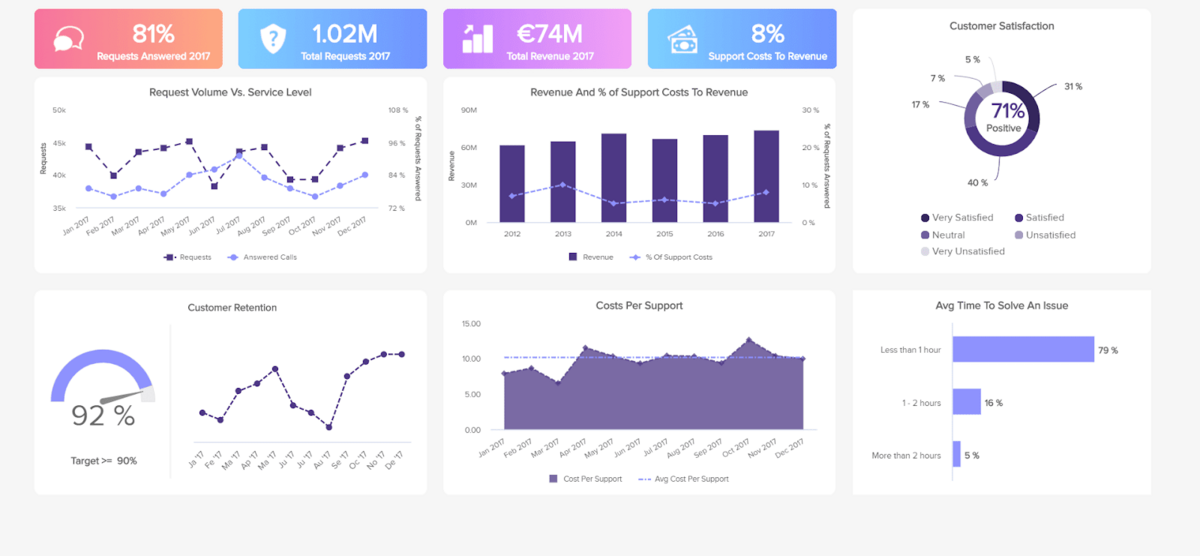
Source: Monday.com
Monday.com is among the best BPM tools in the market and offers several features for managing projects including resource and project management. This tool has been trimmed to do away with several features in typical management tools to improve focus on simple, visually intuitive layouts that clarify the sequence of work. Users of this tool can upload and attach files to cards, mention teammates, including comments, and more features.
Intuitive dashboard – This BPM software tool offers a great project reporting dashboard that can collect data from multiple boards. The progress of each task can be tracked in real-time.
Accounting and invoicing tools – Monday.com can be used for tracking hours, timelines, and invoices. Effective tracking of accounts and invoices can be done using this BPM tool.
Customization – Monday.com can be easily customized according to any kind of management methodology like Kanban Scrum or Lean methodology. Any management methodology that your team works with is compatible with monday.com.
Easy workflow automation – Several useful tools can automate parts of your process. Creative and design, software development, marketing, sales and CRM, task management, and HR are some of the workflows that can be automated with monday.com.
Seamless integrations – Monday.com can seamlessly integrate with several apps like Google Calendar, Google Drive, Slack, Jira, GitHub, and Typeform via Zapier.
Files – This tool allows you to add context to your tasks by uploading any type of file. The Docs feature on Monday.com can turn words into workflows that collaborate in real time.
Pricing – Monday.com offers a 14-day free trial and a free plan for up to 2 users. The costs are $8 per user per month.
3) Interfacing Integrated Management System
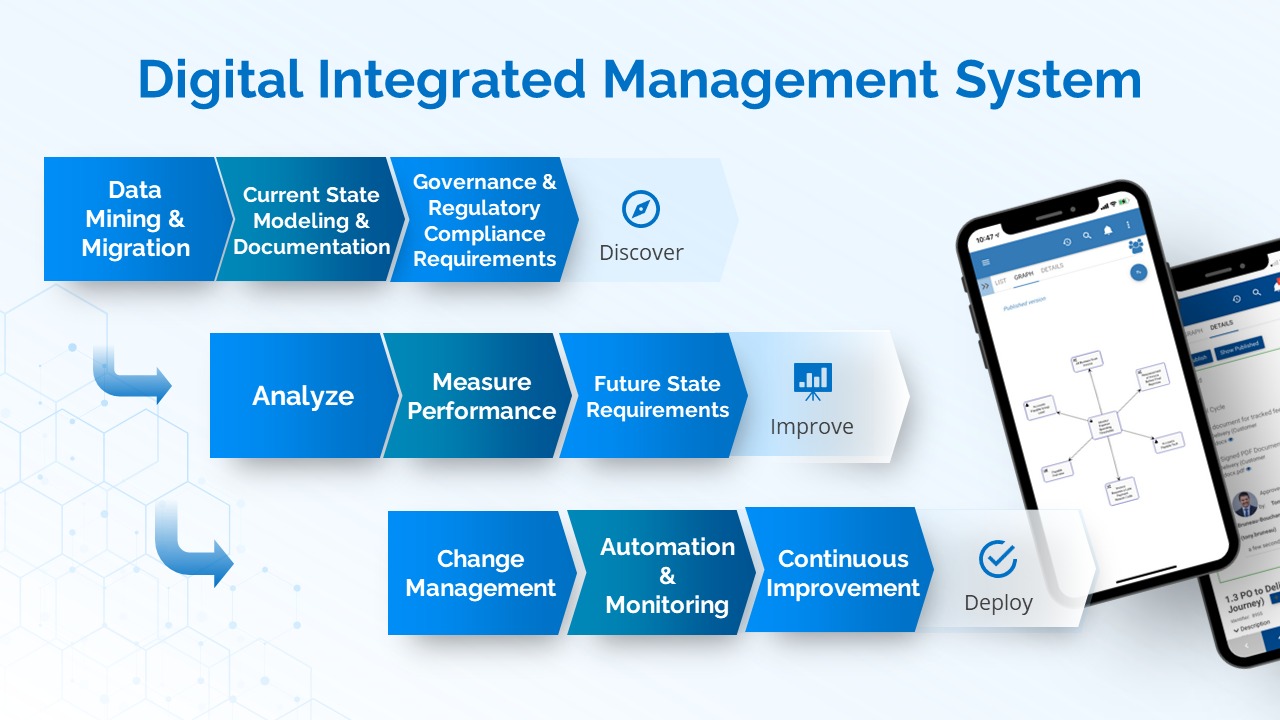
Source: Interfacing
The Enterprise Process Center (EPC) from Interfacing has been ranked among the global leaders by Gartner. This is regarded as the ultimate tool that empowers the digital transformation in an organization – from strategy to execution.
Their solution covers key aspects of workflow automation like process modeling and analysis, collaboration, document management, and auditing. The integrated quality management system in this tool covers the full spectrum of workflow automation – from analysis to governance; from improvement to compliance.
Centralized repository – The core of the EPC solution is the centralized repository that stores and manages all the processes and related information via a user-friendly interface and an intuitive environment.
EPC links all the complex artifacts of an enterprise: objectives, processes, procedures, employees, departments, customers, suppliers, policies, departments, documents, rules, risks, and controls into a single capsule that provides a 360-degree blueprint of the organization’s structure.
Continuous business improvement – Interfacing Integrated Management System minimizes the effort and increases the value of a business process analysis (BPA) and business process improvement (BPI) program by providing a unified platform for continuous business improvement.
Integrates business systems – EPC eliminates the silos and provides the ability to analyze your value streams comprehensively. Users can visualize cost, duration, and risk analysis with an integrative approach.
Supports management methodologies – The holistic approach to analyzing change impacts encourages symbiotic relationships between departments. This approach supports quality initiatives like JIT, Lean, Six Sigma, and ISO. EPC engrains business process improvement into the business culture.
Pricing – EPC is available for a 30-day free trial and a demo. The cost of the solution is $10 per user.
4) Wrike
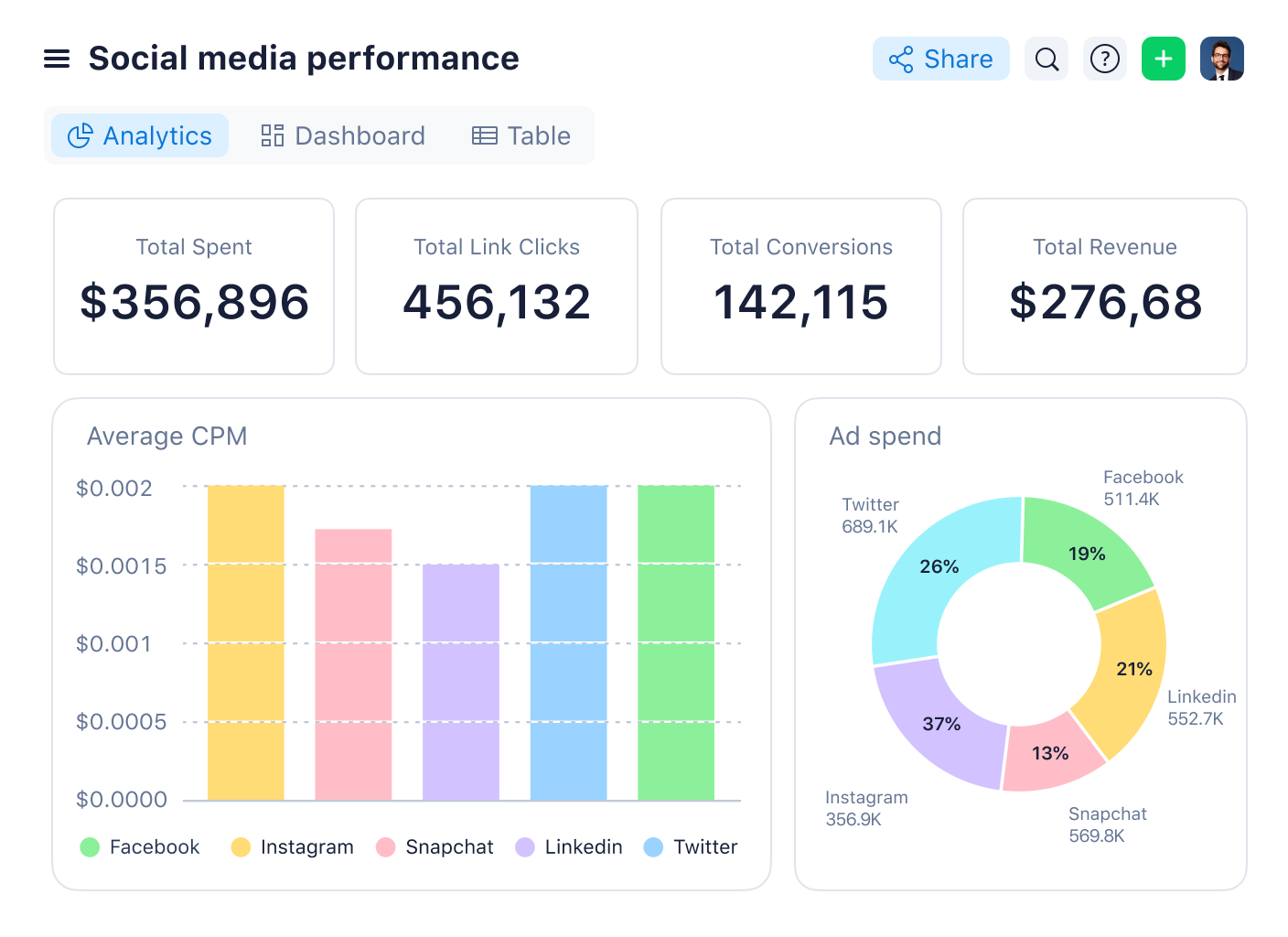
Source : Wrike
Time-consuming business processes can be effectively streamlined and automated with Wrike. Ranked among the top BPM tools that increase automation, modernize workflows, and save time. You can streamline repetitive request processes with Wrike’s powerful and intuitive automation tools.
Wrike can connect over 400 apps for smooth business operations. You can monitor all the edits from a single place and fast-track the approval process by adding feedback directly to digital assets. Wrike is a powerful, easy-to-use business process management software trusted by over 20,000 organizations worldwide.
Customizable – Wrike can be easily customized and configurable as per your business requirements. Process workflows, dashboards, reports, and request forms can be easily customized using Wrike. Organization or team-specific solutions are provided, including marketing teams and professional service teams.
Intuitive user interface – The simple user interface in Wrike enables users to switch between Kanban boards, traditional workload views, and interactive drag-and-drop Gantt charts, which allows them to choose how to manage business process tasks.
The easy-to-use interface and navigation allow you to toggle easily between the home screen and timesheets, dashboards, calendars, reports, and streams. A dedicated help center provides interactive training videos, a thriving community, and a Getting Started guide.
Task control features – Several task control features like task lists, automation, process mapping, process change tracking, organizational process templates, and shared workflows are provided in Wrike.
Integrations – Wrike offers 400+ pre-built native integrations with business process tools. Integrations include file management software from Google, Microsoft, and Dropbox and sales and marketing software like Marketo and Salesforce.
Pricing – The pricing plan starts at $ 9.80 per user per month. 4 different price plans are provided including the free version and plans that offer the ability to invite free external collaborators to a paid amount.
5) Process Bliss
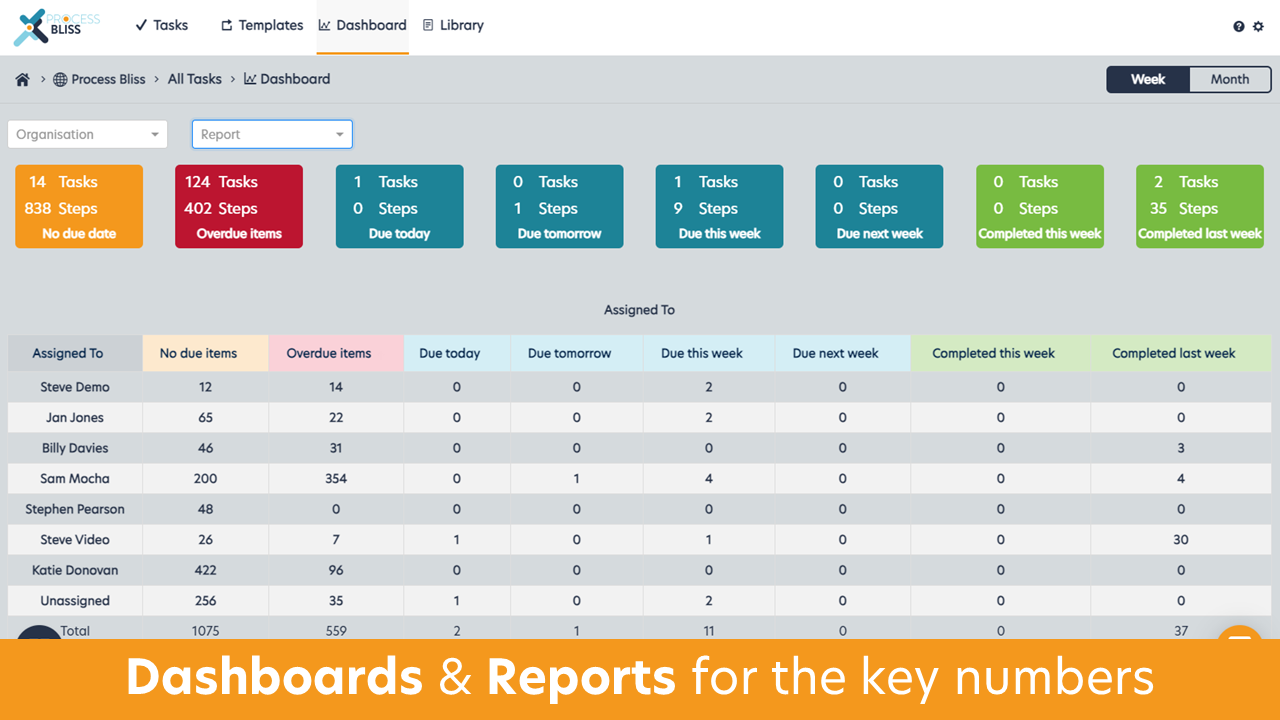
Source : Beslick
Process Bliss is a comprehensive BPM tool that has been designed keeping in mind ease of use and user-friendliness as top priorities. Processes can be created as workflow templates using a flow chart builder in Process Bliss.
The flow chart builder supports decision branching, loops, data/file capture, and dependent due dates in a drag-and-drop environment. Even a person with a non-technical background can easily create automated process workflows.
Process templates – The process templates in Process Bliss are available in a centralized folder that requires permission for access and can be shared externally via URL.
Integrates process and workflow – The most striking feature of Process Bliss is the ability to integrate process and workflow seamlessly. The process templates can be executed as dynamic task checklists and tracked in real-time for progress. Notifications are provided to advise who needs to do what and when. Workflows can be automatically scheduled using recurring events to ensure that items are not missed.
Compliance and audit – Process Bliss provides a complete audit trail of all the activity and changes, which is useful in compliance management. Pre-built process improvement module includes process quality analytics and a process feedback loop for improving workflows on an ongoing basis.
App integration – Other business systems like Office 365, G Suite Salesforce, and other ERP systems can be seamlessly integrated with Process Bliss. More than a hundred integrations can be done via Zapier.
Pricing – Process Bliss is available for a trial period of 14 days. Pricing starts at $10 per user per month.
6) Trisotech
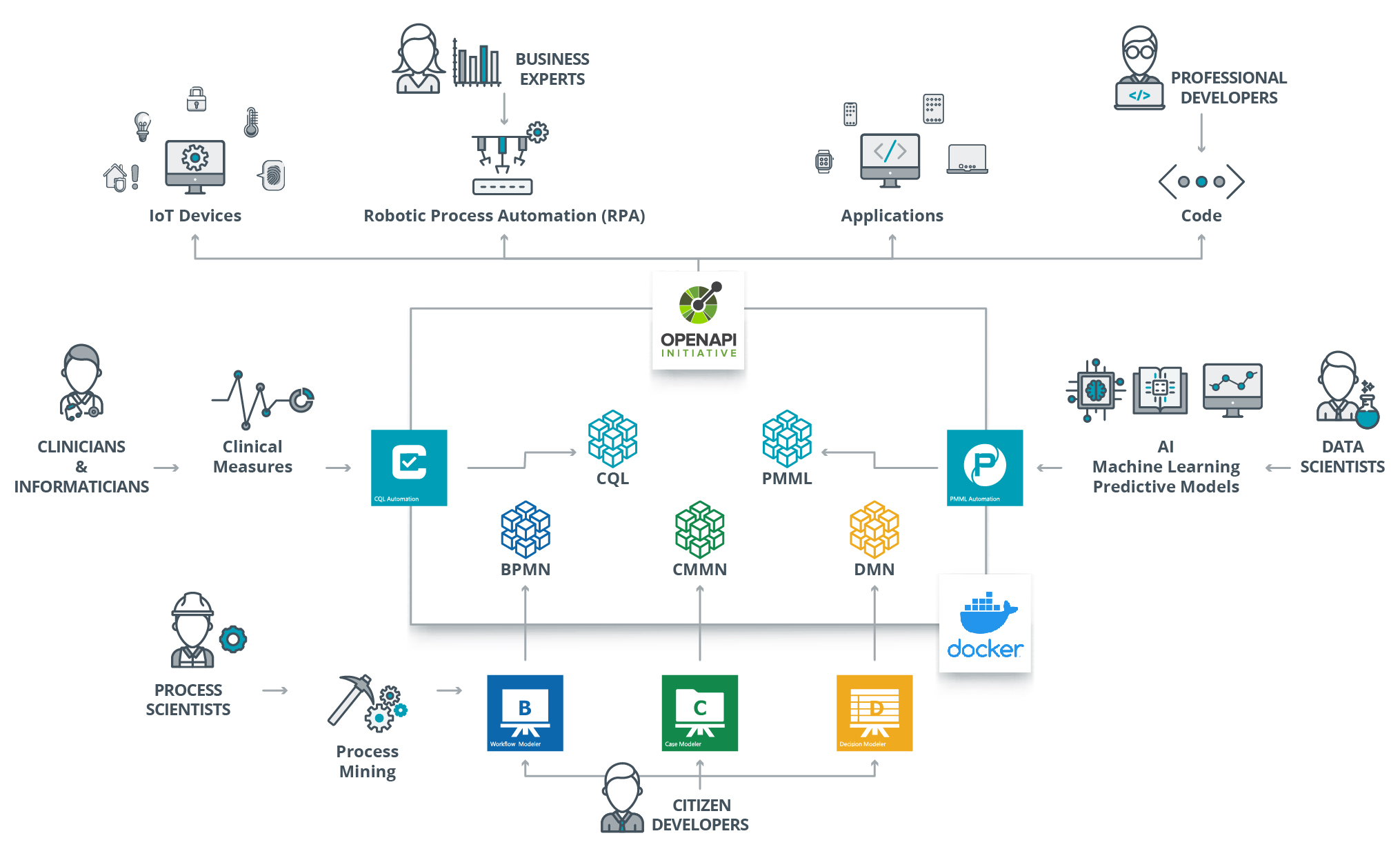
Source : Trisotech
Trisotech is another excellent BPMN tool that offers easy-to-use, low-code BPM tools with workflow modelers designed with industry standards. It offers drag-and-drop BPMN model diagrams, tables, and interface capabilities.
The drag-and-drop interface enables users to build comprehensive models and a rules engine that is annotated with application generation symbols. It offers business process simulation to easily understand and analyze the efficiency of the created workflows in the business design. Trisotech says that though the initial setup requires additional information on time, resources, cost, and control rules for the simulation, it simplifies the overall work which is a smart investment.
Trisotech offers custom-built forms that easily capture information that the BPMN team needs and help them to easily set up the generated applications and developers can jump-start with the production.
Coupled with generative AI, machine learning, and RPA, Trisotech offers advanced decision management functions enabling BPMN to interact with business applications seamlessly without causing a big impact on organizational change.
Project teams can easily optimize the new processes through iterative development. The RPA bots make it easy to orchestrate as many BPMS teams as possible. Also, the low code simplifies workflow management and optimizes business processes quite efficiently.
Trisotech covers different industries in healthcare, finance, and the public sector and offers pricing plans to enterprises on demand.
7) Orchestly
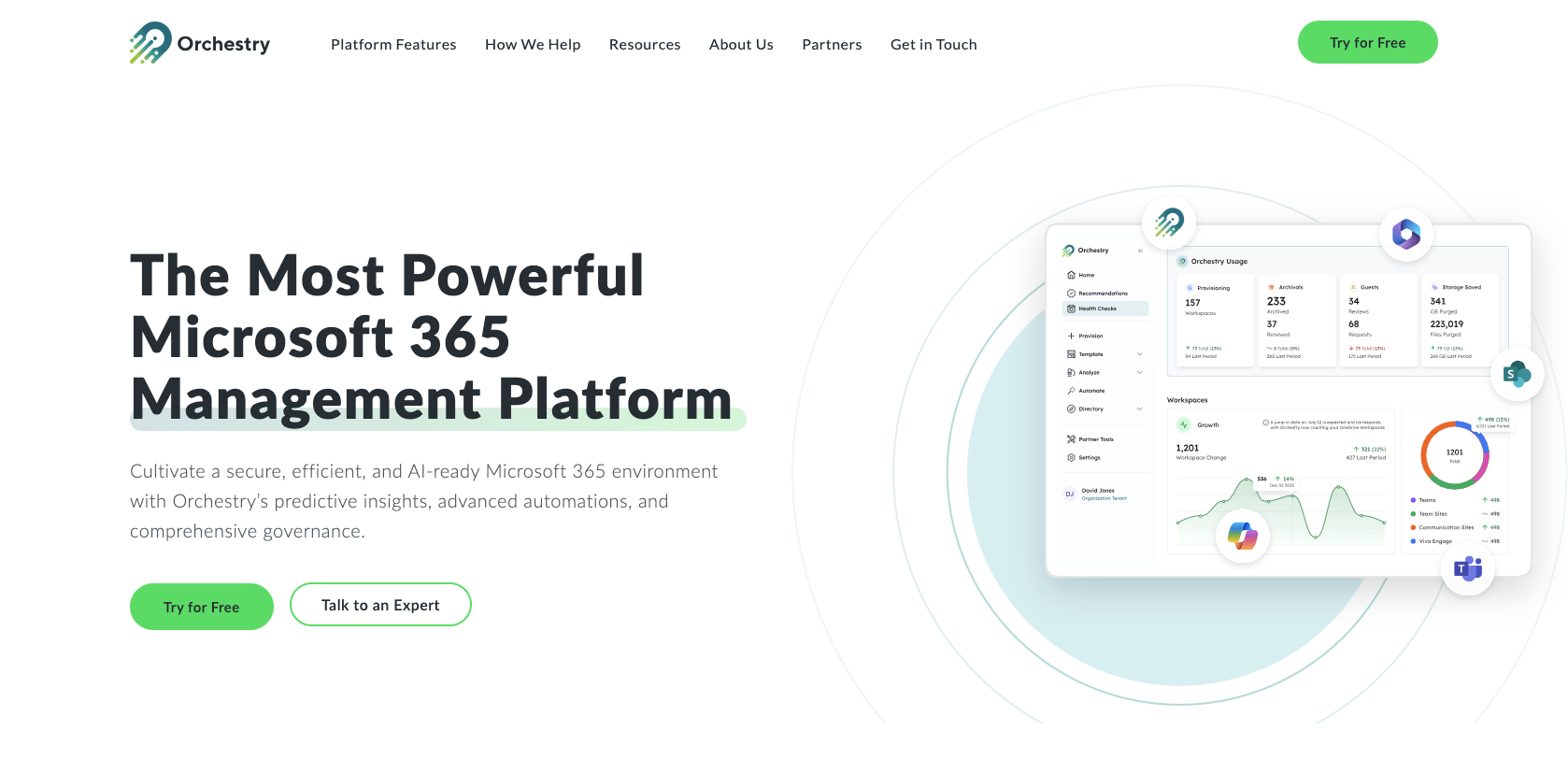
Source : QNTRL
Orchestly is a business process management system that empowers businesses to automate, manage, and optimize their routine business workflows. You can also automate and optimize the standard operating procedures using a simple drag-and-drop platform. This solution has been specifically built for medium and enterprise businesses across industries.
Key business functions like Marketing, HR, Finance, Legan, and IT can be effectively automated using Orchestly. Customizable forms in Orchestly simplify the process of gathering business information. The drag-and-drop workflow builder can be used even by a non-technical person to create simple to complex workflows in the form of flowcharts.
Centralization – Centralized request submission and management provide unparalleled visibility into process statuses. Customized work views and real-time status updates enable managers to stay updated on all the process statuses. Organizational silos are broken down through the centralization of request management.
Process compliance – Orchestly provides full control over workflows through a clear definition of responsibilities at each stage, automating process checks, and enforcing business policies and rules. You can bid goodbye to forgotten tasks, unauthorized actions, and unapproved or delayed requests when you have Orchestly.
Workflow-centric collaboration – You can collaborate seamlessly and automatically with all the work centralized at one location with Orchestly. Access to contextual data, when required, sharing and receiving updates, and keeping stakeholders informed via chat or emails, are some of the capabilities that are provided by this software.
Effective automation – Orchestly minimizes the need for human intervention by automating repetitive and manual tasks. This automation tool assigns requests automatically, automates workflow actions, and generates documents automatically.
Reports and dashboards – Improving your operational KPIs can be done effectively with Orchestly. The reports and dashboards enable team members and managers to track processes and overhaul them where required. Important operational KPIs like workflow duration and usage, custom reports, and SLAs are provided by the software.
Visual orchestration – The drag-and-drop platform enables you to build flexible and scalable business processes that are tailored to meet your business requirements. Features like process logic automation, workflow, and form builder enable powerful visual orchestration.
Integration – Orchestly can connect seamlessly to enterprise systems like Payroll systems, accounting software, and ERPs via APIs, webhooks, and custom functions.
Pricing – Orchestly is available for a 15-day free trial and provides flexible user pricing starting at $8 per month.
8) Formstack
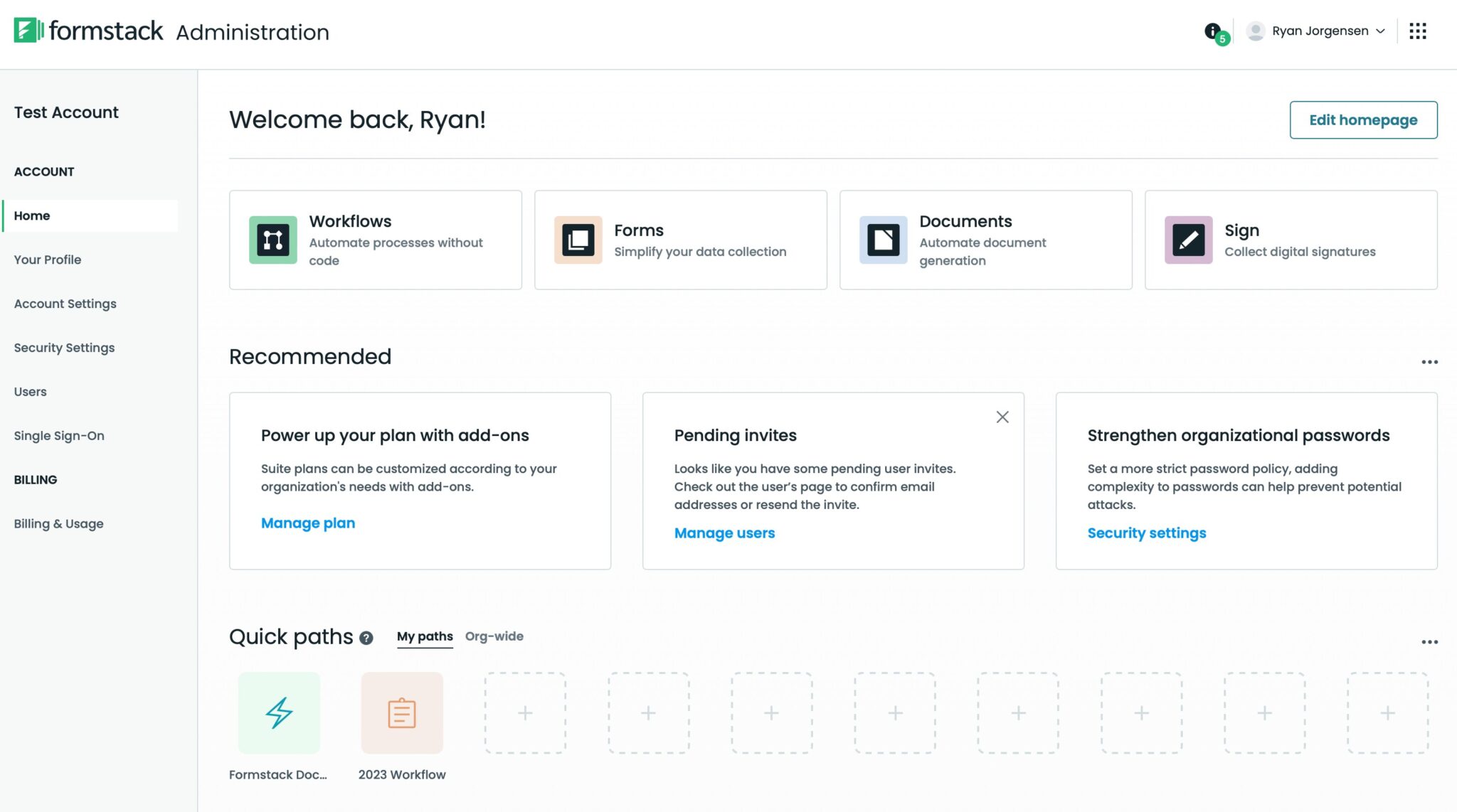
Source : Form Stack
The BPM strategy of Formstack is centered around an easy-to-use form builder that delivers complete and consistent information across the process team. The expansive template library comes with more than 200 pre-built business forms that can be customized.
The software is best suited for growing business process management protocols. Formstack works well for projects that are document-centric. It also includes certain process automation features like an automatic collection of payments, or automatic data collection and routing to relevant stakeholders.
Forms – Formstack allows users to power up their data collection with versatile online forms that do not require any coding.
Documentation – This document-centric solution simplifies document preparation so that you can channel your efforts toward strategic activities.
Digital signatures – With Formstack, the review, and signing of documents can be done from anywhere. Paperwork is eliminated from the documentation process, enabling simpler and more effective management of documents. The native Salesforce tool combines forms, documents, and e-signatures into a single ecosystem.
Streamlining processes – The Formstack platform helps streamline tedious tasks and keep the team organized with a set of productivity suits.
Integrations – Formstack can be seamlessly integrated with CRM, Payments, e-mail, CMS, and Document storage systems. Featured integrations include Salesforce, Amazon S3, Paypal, Stripe, Hubspot, Microsoft, and Airtable.
Pricing – Formstack does not provide any free trial. It is among the highly-priced BPM tools. For the cost of $19 per month per user, the only feature provided is the creation of online forms. Important features of Formstack can be accessed only when you upgrade to the Gold plan priced at $82.50 per month per user.
9) Process Street
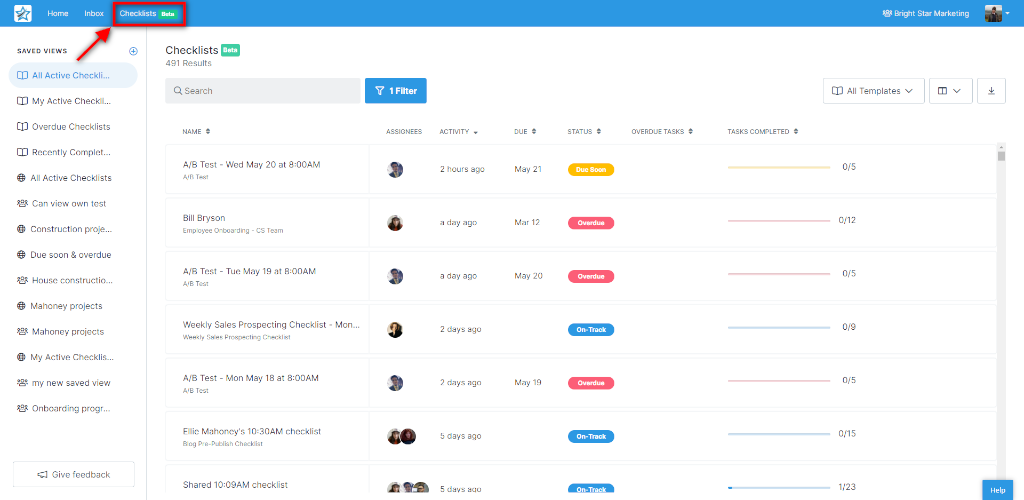
Source : Process Street
As evident from its name, Process Street is a process-driven BPM software tool that adapts well to simple workflow strategies. Although this software does not offer advanced reporting and analytics features like others in this class, it is a great solution for document-driven workflows.
The free-plan welcomes an unlimited number of users, which is a welcome trade-off for being feature-lite in some areas. Process Street breaks up process management into documentation handling, programming recurring tasks, and running trigger-based workflows. With several useful tools for process documentation and workflow automation, Process Street is the ideal choice for teams who want a streamlined process framework.
Collaborative workflows – You can quickly create and assign workflows to your team and track activities from the dashboard. Once tasks are completed, automatic alerts and notifications are triggered.
Process documentation – The simple user interface in Process Street lets you create structured documents within seconds. The intuitive keyboard shortcuts and drag-and-drop form builder make it easy for even a non-technical user to create forms and documents. Forms can be used to collect structured data in workflows. You can also add rich content and media to your documents.
Conditional logic – Truly dynamic workflows can be created based on conditional if/then logic. These dynamic workflows can easily adapt to the changing needs of the team.
Streamlined approvals – With Process Street, you can streamline any process that requires authorization from another person. Single instances or multi-stage or sequential approvals can be created easily with this BPM tool.
App Integration – Process Street can integrate over 1000 apps via Zapier. These integrations enable automatic scheduling and assignment of workflows and updations to other apps whenever actions happen within Process Street.
Pricing- The Business Plan of Process Street starts at $12.50 per user per month.
10) ProWorkflow
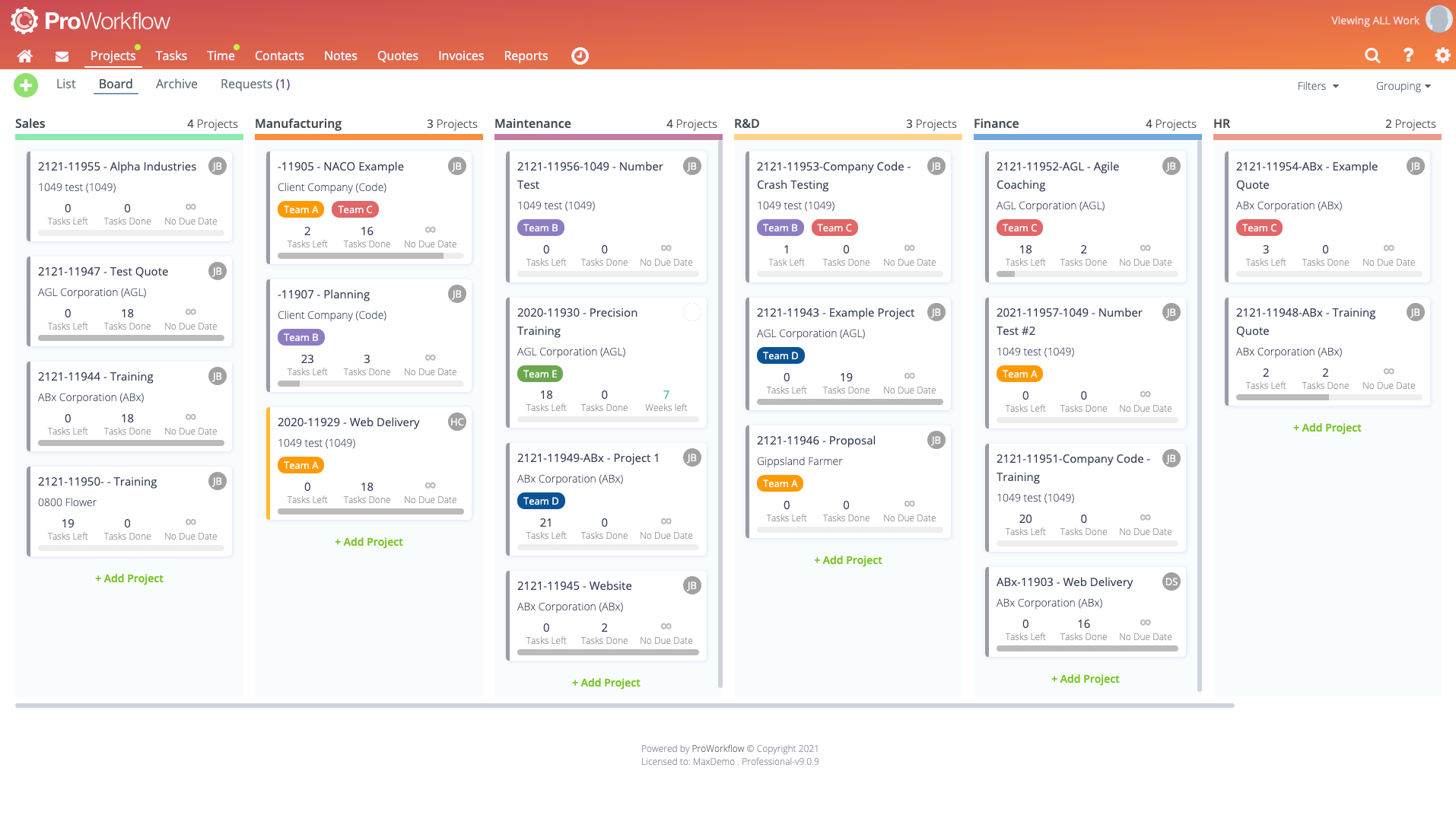
Source : Pro Workflow
ProWorkflow was created in 2002 as a process management solution for internal workflow and communication management. With ProWorkflow you can get a bird’s eye view of all the active projects and tasks, track time, quotes, invoices, recent actions, and recent logins.
Using the ‘Recent Work’ tab users can see who is currently working on what. You can adapt the current and future process planning based on these real-time updates. ProWorkflow projects the current process statuses on an easily understandable Gantt chart timeline.
The drag-and-drop features in the software enable flexible work rescheduling according to new changes in the process. The ProWorkflow app can be used on a touchscreen smartphone or tablet. App Store, Adobe Extension App, Microsoft Team Integration, and Microsoft Outlook Integration are some of the add-ons provided by ProWorkflow.
Project management – The software enables centralized project management by consolidating project details, timelines, and communication data in one place.
Task management – Flexible task types and customizable templates in ProWorkflow enable efficient task-level management. The resource management feature allows you to allocate tasks and view and manage the workload across multiple business teams.
Reporting – ProWorkflow provides standard and custom reporting tools that create comprehensive reports. Using the templates provided by the software, users can create projects, tasks, quotes, and invoices within seconds. Even timesheet entries can be shown in the form of reports to analyze resource utilization.
Workflow management – With ProWorkflow, you can create custom categories, views, and grouping as per unique business requirements. In addition to workflow management, the software provides an invoices and quotes manager as an optional plugin to handle invoicing and quoting.
Customization – You can tailor ProWorkflow to suit your business and brand image. The easy-to-use drag-and-drop form builder tool can be used to customize forms as per business requirements. Timesheet tracking can also be done as per your business requirements.
Notifications and alerts – Automated onscreen and email alerts help you keep your team on track.
Data Security – ProWorkflow provides very high levels of data security through encryption and approval-based access to data.
API integration – The powerful API enables you to integrate the software with several business apps.
Pricing – ProWorkflow provides flexible pricing options like monthly or annual payments. Two types of pricing plans are provided a Professional plan at $20 per month per user, and an Advanced plan at $30 per month per user. A free trial is also provided.
11) Pegasystems (Pega)
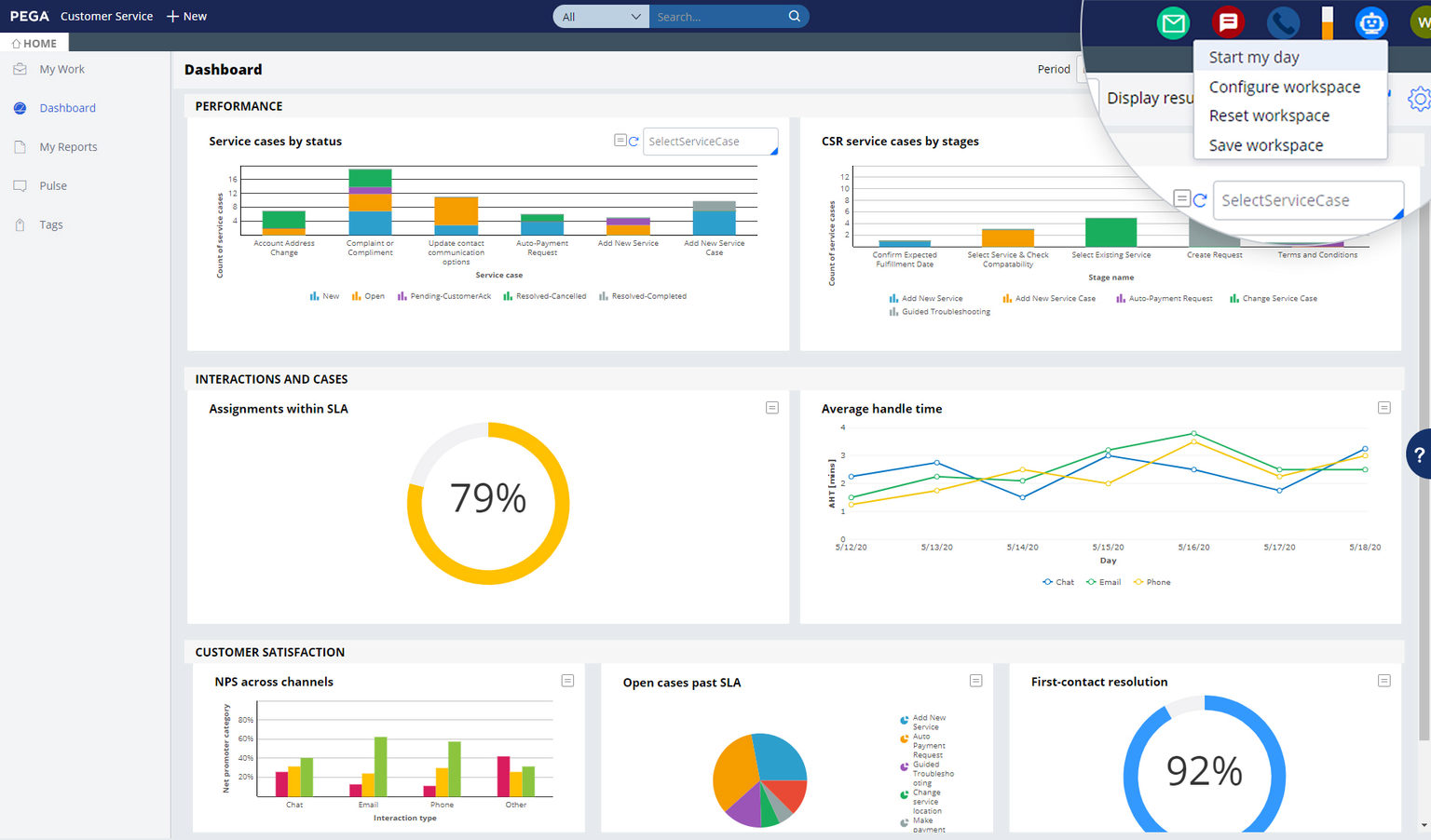
Source : Pega
One of the first BPMS tools Pega comes with a mature rules library and offers time-tested BPMS products that are highly configurable and flexible for specific business needs. Pega offers a low-code suite of BPMS products that have evolved over the years and provide your business with stability.
Pega combines the power of AI and RPA to produce exceptional workflow automation capabilities along with low-code capabilities to support the rapid creation and management of complex workflows and automate repetitive tasks. It enables users with AI-based decision-making and execution to enhance operational efficiency.
Pega offers customizable forms of developing applications and offers frameworks which is a tool to customize applications for different industries such as healthcare, finance, and insurance.
The frameworks provide users with pre-built data models, workflows business rules, and UI templates that can automatically execute the programs which is especially useful for non-technical users.
The BPMS teams will have complete control over the development as Pega’s technical environment offers flexibility for continuous improvement and business transformation. The pre-built templates help teams to jump-start development faster with greater accuracy. In addition, Pega offers support services and training for simplifying the learning process.
AI-based workflow products let companies scale process improvements, modeling, analysis, process redesign, deployment, and operation. It iterates AI and RPA chatbots that streamline operations. Pega also offers predictive models and NLP to forecast customer demand and make informed decisions.
Pega offers three pricing plans starting from $35 per user/month which is the basic plan to $90 per user/month standard plan and a customized plan for enterprises.
12) Bizagi
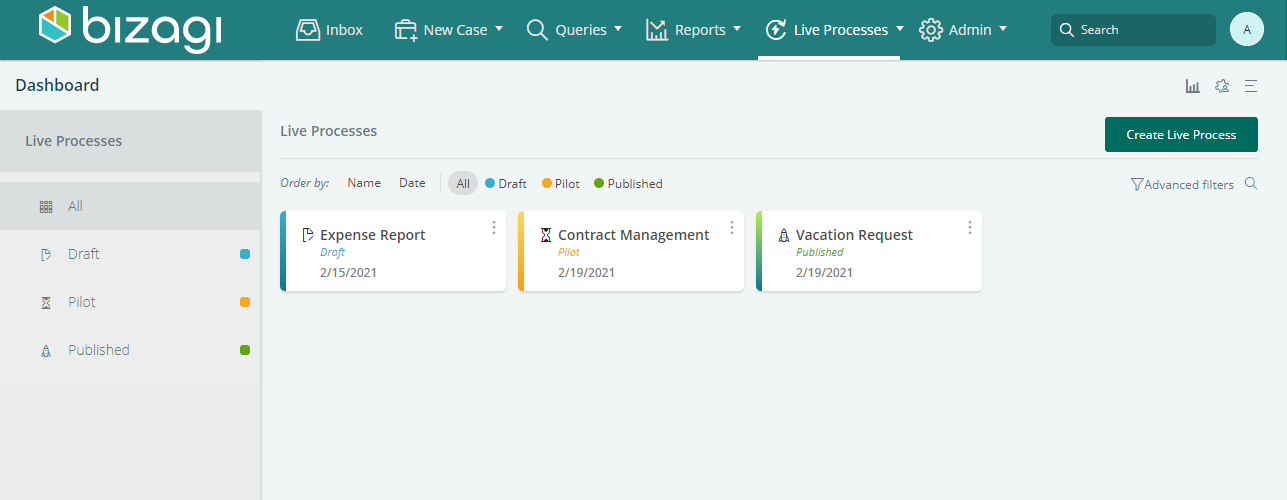
Source : Bizagi
The Bizagi Business Process Modeler has more than 1,000,000 users across the globe. This software collaborates on process modeling, revision history, drag-and-drop environment, and suggestions for various next-best actions driven by AI.
Several useful BPM platforms are available in Bizagi – Automation, Modeler, Studio, Xchange, and Trust Center. It is a low-code platform that enables enterprise-wide orchestration. You pay for only what you need/use with Bizagi.
This tool is steeply focused on BPM standards, which gives it a unique advantage in terms of usability evaluation criteria that make the user more aware of the best practices as they work with the tool.
Intuitive user interface – The easy-to-use interface supports any level of programming. The expert view is also provided for Professional Developers.
Powerful automation – Bizagi provides more than 130 pre-built connectors and integrations for seamless collaboration. These tools can be used to quickly create your custom integrations. Bizagi Sites can be used for creating contextualized experiences.
Integrations – Users can quickly and securely integrate any data source to connect systems and increase information visibility from end to end.
Native cloud PaaS – Teams can deliver rapid innovation and manage with ease on a platform that provides enhanced security, built-in reliability, and high-performance global access.
Pricing – Bizagi is priced at $8 per month per user.
13) Nintex Platform
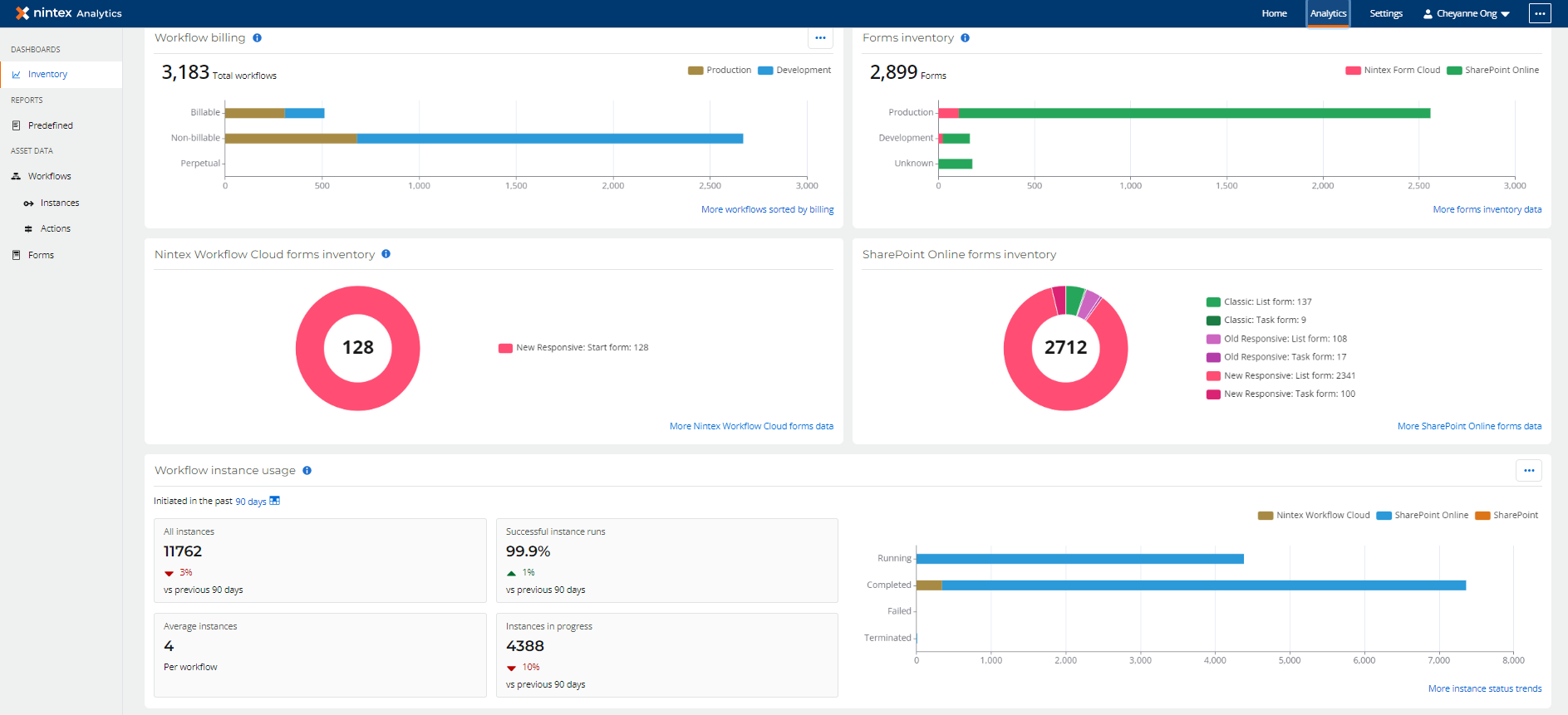
Source : Nintex
The Nintex automation platform is best suited for managing, automating, and optimizing business processes. It provides several features that improve the efficiency of process mapping and maintenance.
The key functionalities provided by the Nintex platform are document generation, process mapping, and mobile app builder. Nintex provides on-premise and cloud deployment options. A mobile app is available for iOS and Android users. Good reviews are available for process automation and SharePoint.
Process management – Nintex provides process mapping and process collaboration features via the Promapp feature. The process mapping feature allows users to plan, map, and govern processes. The process collaboration feature helps create a center of excellence for the organization.
Workflow automation – Nintex enables effective and efficient workflow automation by streamlining and automating manual processes. The repetitive and redundant tasks in a process can be eliminated through automation.
Trained RPA bots can be used for automating routine tasks without involving any coding. The easy-to-use drag-and-drop interface can be used for creating forms that gather structured and unstructured data. Nintex Hawkeye provides deep insights into the effectiveness of the process.
Digital forms – Cumbersome paper forms can be eliminated by using digital forms in Nintex. Accurate and quick data capture is possible with digital forms.
Document generation – The DocGen feature in Nintex can be used to generate documents and enable e-signatures.
Pricing – The standard version starts at $910 per month for unlimited users, and the Enterprise version that includes RPA is priced at $1400 per month for unlimited users.
14) Comindware tracker
![]()
Source : CMW Lab
Comindware is a BPM software that provides key automation functionalities like process modelling and management. It is a no-code platform that incorporates the easy-to-understand drag-and-drop functionality.
Comindware supports both on-premise and cloud deployments and supports Windows and Mac platforms. This BPM software minimizes dependency on IT and empowers non-technical users to design, run, and modify processes using the drag-and-drop functionality.
Graphical workflow builder – The drag-and-drop workflow builder empowers even non-technical persons to create, run, and modify workflows. You can also easily design and configure web forms via graphical UI. You can even make in-the-fly changes to forms in Comindware.
Process and task management – Comindware enables efficient process and task management by monitoring task duration, expenses, and more. Unified task management across workflow tasks and non-process user task lists.
Workflow automation – Comindware provides a single ecosystem that supports workflow design, automation, and execution. Transition and validation of rules for automated workflows, time and condition-based notifications, and automated modification of form fields depending on the workflow step or form data, are some of the workflow automation capabilities provided by Comindware.
Workflow tracking and reporting – Comindware provides complete visibility and real-time control over the status of any item. The single web-based workflow tracking tool provides business analytics, notifications, and alerts, support for mobile platforms, and tailor-made dashboards.
Workflow engine – You can set business rules that guide the path of the workflow and modify them on the fly with Comindware. The workflow engine enables execution and control of group task flow, information capture, and exception handling, and sets workflow tools and execution parameters.
Integration – Comindware can integrate with ERP, CRM, and Document Management Portals to improve business productivity. Fully open web APIs are used for integrations of any scope or complexity. Seamless integration provides unified security and administration capabilities across the entire application portfolio.
Pricing – Pricing starts at $24.99 per user per month. This cost will come down as the number of users increases.
15) Creatio
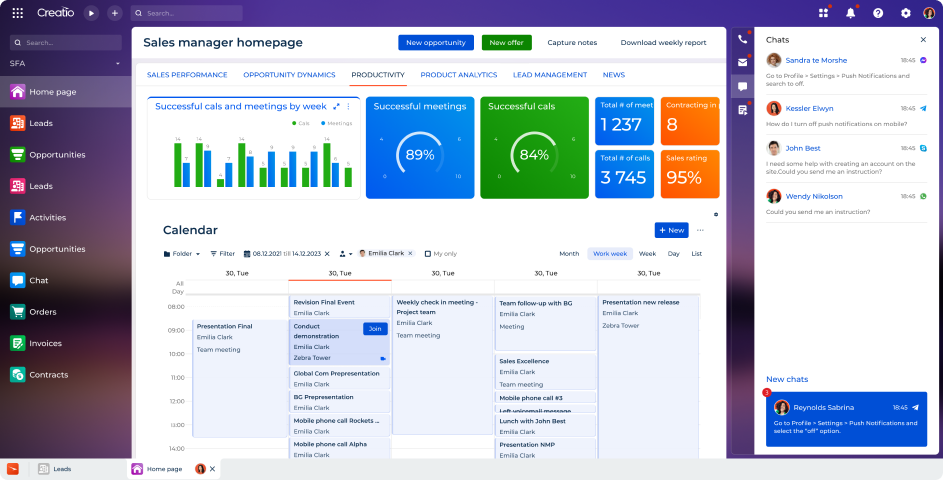
Source : Creatio
Creatio is an intelligent, low-code, and process management platform that provides out-of-the-box solutions and templates. It is a process management platform that enables businesses across industries as well as system integrators to build processes and create custom applications for specific business requirements.
From document approval to collaboration on complex tasks, Creatio provides a complete set of tools for process modelling, execution, monitoring, and analysis. Process designer, process library, and process modelling and analytics are available for process management.
No-code editor – Creatio is a robust no-code editor for BPMN processes. The corresponding business logic is automatically created by the process designer. The no-code case designer helps build dynamic, unstructured processes.
System designer – Creatio provides tools for setting business rules, UI customization, and process analytics.
Core configuration – You can efficiently manage the organizational structure by planning work, tasks, and meetings. You can also implement intelligent technologies to accelerate routine operations.
16) Oracle Process Cloud Service

Source : Oracle
Oracle Process Cloud Service is a low-code, fully-managed platform that can be used for developing, executing, and monitoring enterprise-level processes. In this BPM tool, there is a Composer environment that aids visual modeling and testing of the BPM solution. Another important component of the BPM solution is the Workspace interface for end-users that can be accessed via web and mobile devices for initiating tasks, monitor workflows, and view forms.
Key functionalities of Oracle PCS are collaborative visual modeling via drag-and-drop builder. The live dashboards can be used for tracking performance and task statuses, and for identifying bottlenecks in the process.
Visual modeling – The drag-and-drop process, form rules, and document designer in Oracle is a 100% browser-based tool that is ideal for IT collaboration.
Responsive UI – This BPM tool enables multi-channel app delivery with the help of responsive UIs that are deployed across desktop and mobile platforms, which eliminates the need for rework.
Pricing
Subscription includes per-active-user-hour billing plus monthly execution packs.
Typical minimums: 5 users and at least one execution pack..
17) Appian BPM Suite

Source : Appian
The Appian BPM suite is an integrated automation platform that blends BPM, RPA, case management, process intelligence, and intelligent document processing. This unified platform enables rapid development of complex enterprise processes. The AI-powered designer in the BPM tool enables visual process modeling embedded with AI suggestions.
Key functionalities of this BPM tool are the built-in RPA and intelligent document processing that can automate tasks and extract document data seamlessly.
Visual process modeling – The process designer in Appian BPM suite is equipped with embedded AI suggestions. The drag-and-drop workflow builder simplifies workflow building.
Real-time Analytics – The BPM tool provides real-time updates by way of live dashboards and compliance monitoring across workflows.
Pricing
Standard Edition: $75/user/month.
Role-based pricing: “Infrequent” at $9/user/month, “Input-Only” at $2/user/month.
17) IBM Business Automation Workflow

Source : IBM
IBM business automation workflow is a platform that is used to create workflow applications that improve productivity. Workflow applications can seamlessly coordinate work between tasks performed by humans and automated tasks to streamline daily business operations.
Key functionalities of the BPM tool include unified BPM and case management. The tool also provides analytics and monitoring capabilities with the help of KPIs and dashboards. The generative AI support helps generate documents automatically and issue emails in BAW.
Workflow – IBM Business Automation Workflow automates processes and cases for agility, visibility,and consistency across business operations.
Content – IBM FileNet Content Manager provides enterprise content management to enable secure access, collaboration support, and content synchronization.
Insights – IBM Business Automation Insights provides dashboarding and data science capabilities from the events and business data collected from Cloud Pak for Business Automation Services.
Pricing
Available via subscription: user-based or consumption models.
On-prem perpetual licenses are also offered.
18) Emakin

Source : Emakin
Emakin is a single platform that accelerates your digital transformation journey. This is a process based low-code platform that can automate business operations. This BPM tool provides a flexible platform for digitizing business processes rapidly, easily, and safely. The user-friendly business modeling, business activity monitoring, and rich task and case management capabilities in this tool make it a useful automation tool for business processes.
Rule Engine – The rules engine centralizes business rules and creates a single source of truth that prevents hard-coded rules in applications.
Case management – Case management enables organizations to manage unpredictable, information-centric work that increases productivity and ensures continuity.
Pricing:
Standard (Free): Up to 10 users, 10 GB storage, 25 GB bandwidth.
Advanced: $90/month.
Enterprise: Custom pricing for larger deployments.
18) Red Hat Process Automation Manager

Source : Red Hat
Redhat Process Automation manager is a comprehensive platform for business process management that can be deployed across multiple cloud environments. The automation manager is part of the Red Hat Middleware portfolio, which is a set of products for intelligently automating business decisions and processes.
Users can enforce business policies and procedures, automate business operations, and measure the results of business activities across heterogeneous environments.
Process services – Powerful runtime environment for execution of process models. Supports execution of BPMN 2.0 process models and Case Management Model Notation 1.1 case models.
Cloud-native development – Build in the cloud, for the cloud. Deploy completed models as containerized microservices on the Red Hat OpenShift.
Conclusion
The top BPM platforms that we have listed above offer unique features of their own. You can choose the BPM tool that fits your business and budget requirements. Cflow is among the best BPM tools in the market that provide total value for your money. To explore the complete set of features provided by Cflow, sign up for the free trial.
18) ServiceNow Workflow Automation

Source : Servicenow
ServiceNow automation platform can be used to build, monitor, and optimize highly efficient no-code automated workflows. You can streamline your workflows to reduce costs, increase productivity, and eliminate repetitive tasks. Key functionalities include automation of workflows with reusable components, build and deploy multi-step workflows easily with low code or generative AI.
Process automation designer – Build and manage multiple complex workflows with no code playbooks.
Flow designer – Automate business processes as digital workflows across departments, apps, and systems.
Automation Engine – Automate and connect anything to ServiceNow with a unified approach to hyperautomation.
Pricing
Tiered licensing example: ITSM $90–100/user/month; ITOM $150–200/user/month.
Enterprise packages are quote-based.
18) Alfresco Platform

Source : Alfresco
Alfresco Process Automation platform (APA) is a low code application development platform available as a service on Alfresco Cloud. This automation platform has been designed exclusively for organizations to quickly and easily create intelligent solutions that orchestrate and streamline from simple to complex content-centric business processes. The solution is meant to serve multiple business domains and its cloud-native architecture offers maximum availability and dynamic scaling.
Modeling application – This module is used by professional developers and non-technical power users to create, update, and release applications.
Admin application – This module is used by administrators to deploy applications, manage user permissions, and monitor deployed applications.
Digital workspace – This module is where end-users can start new content-centric processes, and manage their work.
Pricing
Named-user pricing: Starts $100,000/year for 100 users.
AWS Marketplace: 100 users = $102,720/year; 300 users = $198,300/year; 1000 users = $359,340/year.
18) Bonita Soft

Source : Bonita Soft
This BPA-based automation blog provides cutting-edge technologies to streamline operations, optimize workflows, and drive unstoppable growth. You can automate your business processes, connect your systems, and create impactful experiences. You can build powerful workflows with drag-and-drop simplicity that seamlessly integrate your entire tech ecosystem. From legacy systems to modern applications, Bonita unifies everything on a single platform.
Design and integrate – Successful digital transformation starts with well-designed, process-driven applications. You can model, design, and integrate applications that connect people, processes, and systems seamlessly.
Process automation – You can seamlessly automate, optimize, and scale your business processes, based on BPA principles. Bonita process automation empowers organizations to streamline operations, reduce manual tasks, and accelerate digital transformation.
Pricing
Community: Free.
Enterprise: ~$40,000/year license
18) Microsoft Power Automate

Source : Microsoft
Microsoft Power Automate is a comprehensive automation solution that optimizes business processes across nearly unlimited systems. You can discover, automate, orchestrate, and extend processes with Power Automate. You can get deeper visibility and control with less effort with Managed Environments. Offers AI-driven capabilities like AI-builder that allows you to automate data extraction, prediction, and decision-making processes.
AI Authoring – You can create, edit, and extend process automation faster than natural language with Copilot.
Orchestration – Stay in control with 360-degree live monitoring, centralized governance, elastic scaling, and more.
Pricing
Free/Included: Basic flows with standard connectors.
Premium plan: $15/user/month (cloud flows + attended RPA).
Per-flow plan: $150/bot/month for unattended RPA.
Hosted RPA add-on: $215/bot/month.
Process mining: $5,000/tenant/month.
18) Filestage

Source : Filestage
This is a collaboration platform that helps your organization speed up the content review and approval process by automating time-consuming tasks. Automated filesharing, reminders, and status updates in Filestage reduce the time spent on manual tasks, and more time to focus on other productive activities. This tool also offers an integration with Zapier for enhancing workflows.
Customize workflows – Create and customize review workflows with multiple stages and reviewers to make sure content seamlessly progresses through the approval process.
Integration – Filestage seamlessly integrates with applications like Zapier, Slack, Monday, Adobe, and Notion, for building the most efficient workflows.
Pricing
Free: Unlimited reviewers, 2 active projects.
Basic: $59–99/month (10 active projects).
Professional: $299/month.
Enterprise: Custom pricing
Conclusion
The top BPM platforms that we have listed above offer unique features of their own. You can choose the BPM tool that fits your business and budget requirements. Cflow is among the best BPM tools in the market that provide total value for your money. To explore the complete set of features provided by Cflow, sign up for the free trial.
FAQs
1) What does BPMS mean?
BPMS stands for Business Process Management Systems and involves software that automates inefficient business processes by designing, modeling, executing, monitoring, and optimizing. Not only the IT sector but can be used by non-IT businesses too.
2) What is the difference between BPM and BPMS?
Business Process Management (BPM) is the management discipline that takes care of enhancing business processes by creating, developing, optimizing, measuring, and automating business processes. Whereas BPMS (Business Process Management System), is the management tool that assists in achieving the enhancement of the processes.
3) What are some of the benefits of adopting BPM?
Here are some of the essential functionalities you can acquire with a BPM tool:
- Aids in transforming business processes to be enhanced, efficient, and cost-effective
- Remove bottlenecks and improve the productivity of the workforce
- Seamless monitoring and tracking of progress of the tasks, compliance, and employee performance
- Generates automated workflows and decodes the complexity of the operations
- Elevates customer and employee satisfaction rate
- Improves the consistency and reliability of the processes, and ensures proper output delivery
4) Who can use BPMS?
Generally, BPM software is commonly used by medium to large organizations as they tend to have several clients, projects, and multi-level processes that require proper streamlining. Business Process Management is achieved by leveraging an automation tool to create effective process workflows.
All the essential business processes such as employee onboarding, procurement, expense management and reporting, accounts management, compliance regulation, invoice approval, project management, customer relationship management, and more can be effectively streamlined and optimized. BPM tools are best for setting and achieving long-term milestones, process improvement, and much more.
5) Is BPMS safe?
Business Process Management works with confidential information and sensitive data like customer data, business information, financial records, etc. Hence, privacy and security is a crucial part of the management process.
BPM solutions offer data encryption to the users with features like cloud storage and role-based access control that will help maintain the security and privacy of the data that is handled.
6) What is the expected ROI of BPMS?
Productivity is the most important reward a business process management solution offers. Improved productivity is the result of reduced costs and other resources. The four major areas to consider when calculating Return on Investment:
- Process efficiency
- Cost reduction
- Error reduction
- Increased revenue
What should you do next?
Thanks for reading till the end. Here are 3 ways we can help you automate your business:

Do better workflow automation with Cflow
Create workflows with multiple steps, parallel reviewals. auto approvals, public forms, etc. to save time and cost.

Talk to a workflow expert
Get a 30-min. free consultation with our Workflow expert to optimize your daily tasks.

Get smarter with our workflow resources
Explore our workflow automation blogs, ebooks, and other resources to master workflow automation.


